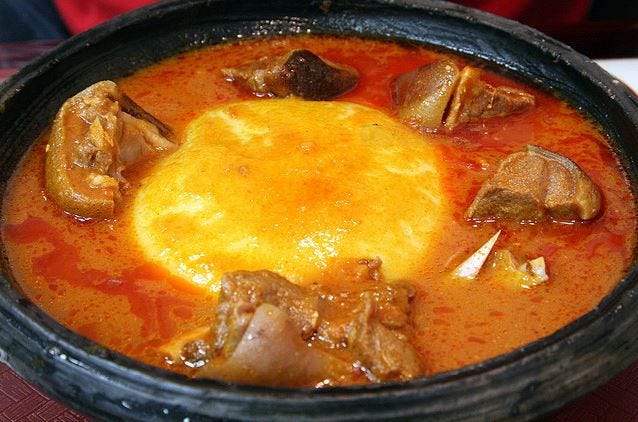Ghanaian Fufu
Estimated reading time:

Ghana, a country known for its rich cultural tapestry and diverse culinary landscape, boasts a traditional dish that holds a special place in the hearts and homes of many Ghanaians – Fufu. More than just a meal, Fufu is a symbol of communal gatherings, familial ties, and the vibrant flavors that define Ghanaian cuisine.
Understanding Fufu
Fufu is a starchy side dish that serves as a staple in Ghanaian cuisine. What sets it apart is not just the ingredients but the meticulous process of its preparation and the communal aspect of its consumption. The primary ingredients for Fufu include cassava, plantains, or yams, which are boiled, pounded, and molded into a smooth, elastic, and dough-like consistency.
The Preparation Process
The preparation of Fufu is an art that has been passed down through generations. The first step involves selecting and peeling the starchy vegetables, which are then boiled until tender. After boiling, the vegetables are pounded using a large wooden mortar and pestle. This labor-intensive process requires skill and strength, and the repetitive pounding is often accompanied by rhythmic chants or songs, turning the preparation into a communal and joyous event.
The end result is a smooth, stretchy, and malleable dough-like substance that is formed into rounded balls or portions. These portions are traditionally served with various soups, stews, or sauces, creating a dynamic and flavorful combination.
Fufu Varieties
Ghana's culinary diversity is reflected in the various types of Fufu prepared across different regions. While the most common variants are cassava, plantain, and yam Fufu, each region may have its unique twist on the dish. Some regions may incorporate cocoyam or maize, adding depth to the flavors and textures.
Communal Dining Experience
Fufu is not merely a meal but a cultural experience. Traditionally, Fufu is enjoyed in communal settings, with family and friends gathering around a large bowl of soup or stew. The Fufu portions are torn off and molded into a small well, creating a perfect vessel for scooping up the savory accompaniment. This communal act of tearing and dipping fosters a sense of togetherness, making every meal a celebration of unity and shared heritage.
Health Benefits
Beyond its cultural significance, Fufu also offers nutritional benefits. The starchy base provides energy, and the dish is often paired with protein-rich soups, vegetables, and lean meats, creating a well-balanced and wholesome meal.
Conclusion
Ghanaian Fufu is more than a culinary delight; it is a cultural emblem that connects people through the joy of shared meals and the art of preparation. Whether enjoyed in the heart of Ghana or savored in international kitchens, Fufu represents the spirit of unity, tradition, and the unique flavors that make Ghanaian cuisine a treasure worth exploring.
